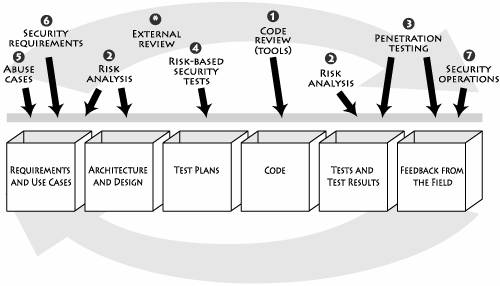Chapter 3. Introduction to Software Security Touchpoints
Chapter 3. Introduction to Software Security Touchpoints[1]
A key aim of this book is to explore and describe a set of software security best practices that I call touchpoints. Putting software security into practice requires making some changes to the way organizations build software. The good news is that these changes do not need to be fundamental, earth shattering, or cost prohibitive. In fact, adopting a straightforward set of engineering best practices, designed in such a way that security can be interleaved into existing development processes, is often all it takes. Integrating software security best practices into the software development lifecycle is the center of the three pillars of software security. The software security best practices that I prescribe have their basis in good software engineering and involve explicitly pondering the security situation throughout the software lifecycle. This means knowing and understanding common risks, designing for security, and subjecting all software artifacts to thorough, objective risk analyses and testing. During these activities, software risk should be explicitly tracked and monitored according to the RMF presented in Chapter 2. This chapter presents a quick introduction to the software security touchpoints (a 50,000-foot view, really) and suggests an ordering for their adoption. Figure 3-1, which also adorns the inside front cover of this book, specifies the software security touchpoints and shows how software practitioners can apply them to the various software artifacts produced during software development. This means understanding how to work security engineering into requirements, architecture, design, coding, testing, validation, measurement, and maintenance. Figure 3-1. Lightweight software security best practices called touchpoints are applied to various software artifacts. The best practices are numbered according to effectiveness and importance. Note that by referring only to software artifacts, we can avoid battles over any particular process. Although the artifacts are laid out according to something that looks like a traditional waterfall model in the picture, most organizations follow an iterative approach today, which means that touchpoints will be cycled through more than once as the software evolves. In any event, by focusing on the artifacts we can avoid broader process issues (including the ever-present warfare surrounding which software process is the one true way and the light). As I discuss in Chapter 1, the software security touchpoints are designed to be process agnostic. That is, the touchpoints can be applied no matter which software process you use to build your software. As long as you are producing some minimal set of software artifacts (and every project should at least be producing code!), you can apply the touchpoints. I used to present the software security touchpoints in order from left to right. Although that works OK, a better pedagogical approach is to order the touchpoints by their natural utility and present them in some sort of ranking. Some touchpoints are by their very nature more powerful than others, and you should adopt the most powerful ones first. Here are the touchpoints, in order of effectiveness:
The ordering I describe will not be a perfect fit for every organization. In fact, the ordering reflects a bias developed over many years of applying these practices in code-o-centric organizations. For that reason, code review comes before architectural risk analysis. However, the fact is that both of the top two touchpoints are critical. If you do code review and skip architectural risk analysis, you will not properly address the software security problem. Harking back to my definitions in Chapter 1, software defects that lead to security problems come in two varieties: bugs and flaws. Code review aims at finding the bugs. Architectural risk analysis aims at finding the flaws. If you skip one or the other, you're most likely to solve only half the problem. (Remember the 50/50 bug/flaw split.) In any event, the top two touchpoints can be swapped around without any loss of generality. As for the rest of the touchpoints, the ranking I present is based on years of experience applying the touchpoints at many different kinds of organizations, ranging from large independent software vendors to huge credit card consortiums. The ordering is not absolute. However, any attempt to change the order, say, by doing penetration testing before you do code review, is likely to be not as successful as the way I suggest. Ironically, the "penetration testing first" ordering is the ordering found in most organizations dealing with software security today, especially those shops where the security division is pushing software and application security. This ordering reflects the reactive approach to security that I am trying to counter by talking about building security in and by involving actual builders in the process. Big organizations can adopt several touchpoints simultaneously in some cases. For more on adopting touchpoints in a large enterprise, see Chapter 10. |
EAN: 2147483647
Pages: 154